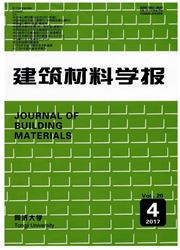

 中文摘要:
中文摘要:
A model of damage to fresh concrete in a corrosive sulphate environment was formulated to investigate how and why the strength of corroded concrete changes over time. First, a corroded concrete block was divided into three regions: an expanded and dense region; a crack-development region; and a noncorroded region. Second, based on the thickness of the surface corrosion layer and the rate of loss of compressive strength of the corroding region, a computational model of the concrete blocks’ corrosion-resistance coefficient of compressive strength in a sulphate environment was generated. Third, experimental tests of the corrosion of concrete were conducted by immersing specimens in a corrosive medium for 270 d. A comparison of the experimental results with the computational formulae shows that the calculation results and test results are in good agreement. A parameter analysis reveals that the corrosion reaction plays a major role in the corrosion of fresh concrete containing ordinary Portland cement,but the diffusion of the corrosion medium plays a major role in the corrosion of concrete mixtures containing fly ash and sulphate-resistant cement. Fresh concrete with a high water-to-cement ratio shows high performance during the whole experiment process whereas fresh concrete with a low water-to-cement ratio shows poor performance during the late experiment period.
 英文摘要:
英文摘要:
A model of damage to fresh concrete in a corrosive sulphate environment was formulated to investigate how and why the strength of corroded concrete changes over time. First, a corroded concrete block was divided into three regions: an expanded and dense region; a crack-development region; and a noncorroded region. Second, based on the thickness of the surface corrosion layer and the rate of loss of compressive strength of the corroding region, a computational model of the concrete blocks' corrosion-resistance coefficient of compressive strength in a sulphate environment was generated. Third, experimental tests of the corrosion of concrete were conducted by immersing specimens in a corrosive medium for 270 d. A comparison of the experimental results with the computational formulae shows that the calculation results and test results are in good agreement. A parameter analysis reveals that the corrosion reaction plays a major role in the corrosion of fresh concrete containing ordinary Portland cement,but the diffusion of the corrosion medium plays a major role in the corrosion of concrete mixtures containing fly ash and sulphate-resistant cement. Fresh concrete with a high water-to-cement ratio shows high performance during the whole experiment process whereas fresh concrete with a low water-to-cement ratio shows poor performance during the late experiment period.
 同期刊论文项目
同期刊论文项目
 同项目期刊论文
同项目期刊论文
 The applicable span-height ratio of steel reinforced concrete cross beam based on deflection control
The applicable span-height ratio of steel reinforced concrete cross beam based on deflection control 期刊信息
期刊信息
